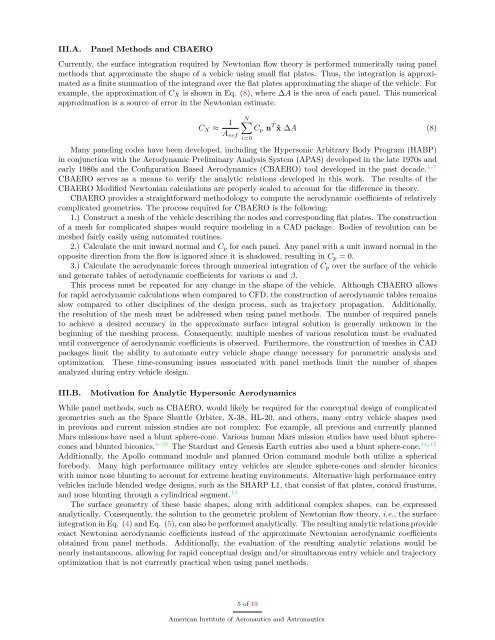Analytic Hypersonic Aerodynamics for Conceptual Design of Entry ...
Analytic Hypersonic Aerodynamics for Conceptual Design of Entry ...
Analytic Hypersonic Aerodynamics for Conceptual Design of Entry ...
You also want an ePaper? Increase the reach of your titles
YUMPU automatically turns print PDFs into web optimized ePapers that Google loves.
III.A. Panel Methods and CBAERO<br />
Currently, the surface integration required by Newtonian flow theory is per<strong>for</strong>med numerically using panel<br />
methods that approximate the shape <strong>of</strong> a vehicle using small flat plates. Thus, the integration is approximated<br />
as a finite summation <strong>of</strong> the integrand over the flat plates approximating the shape <strong>of</strong> the vehicle. For<br />
example, the approximation <strong>of</strong> CX is shown in Eq. (8), where ∆A is the area <strong>of</strong> each panel. This numerical<br />
approximation is a source <strong>of</strong> error in the Newtonian estimate.<br />
CX ≈ 1<br />
Aref<br />
N<br />
Cp n T ˆx ∆A (8)<br />
i=0<br />
Many paneling codes have been developed, including the <strong>Hypersonic</strong> Arbitrary Body Program (HABP)<br />
in conjunction with the Aerodynamic Preliminary Analysis System (APAS) developed in the late 1970s and<br />
early 1980s and the Configuration Based <strong>Aerodynamics</strong> (CBAERO) tool developed in the past decade. 4–7<br />
CBAERO serves as a means to verify the analytic relations developed in this work. The results <strong>of</strong> the<br />
CBAERO Modified Newtonian calculations are properly scaled to account <strong>for</strong> the difference in theory.<br />
CBAERO provides a straight<strong>for</strong>ward methodology to compute the aerodynamic coefficients <strong>of</strong> relatively<br />
complicated geometries. The process required <strong>for</strong> CBAERO is the following:<br />
1.) Construct a mesh <strong>of</strong> the vehicle describing the nodes and corresponding flat plates. The construction<br />
<strong>of</strong> a mesh <strong>for</strong> complicated shapes would require modeling in a CAD package. Bodies <strong>of</strong> revolution can be<br />
meshed fairly easily using automated routines.<br />
2.) Calculate the unit inward normal and Cp <strong>for</strong> each panel. Any panel with a unit inward normal in the<br />
opposite direction from the flow is ignored since it is shadowed, resulting in Cp = 0.<br />
3.) Calculate the aerodynamic <strong>for</strong>ces through numerical integration <strong>of</strong> Cp over the surface <strong>of</strong> the vehicle<br />
and generate tables <strong>of</strong> aerodynamic coefficients <strong>for</strong> various α and β.<br />
This process must be repeated <strong>for</strong> any change in the shape <strong>of</strong> the vehicle. Although CBAERO allows<br />
<strong>for</strong> rapid aerodynamic calculations when compared to CFD, the construction <strong>of</strong> aerodynamic tables remains<br />
slow compared to other disciplines <strong>of</strong> the design process, such as trajectory propagation. Additionally,<br />
the resolution <strong>of</strong> the mesh must be addressed when using panel methods. The number <strong>of</strong> required panels<br />
to achieve a desired accuracy in the approximate surface integral solution is generally unknown in the<br />
beginning <strong>of</strong> the meshing process. Consequently, multiple meshes <strong>of</strong> various resolution must be evaluated<br />
until convergence <strong>of</strong> aerodynamic coefficients is observed. Furthermore, the construction <strong>of</strong> meshes in CAD<br />
packages limit the ability to automate entry vehicle shape change necessary <strong>for</strong> parametric analysis and<br />
optimization. These time-consuming issues associated with panel methods limit the number <strong>of</strong> shapes<br />
analyzed during entry vehicle design.<br />
III.B. Motivation <strong>for</strong> <strong>Analytic</strong> <strong>Hypersonic</strong> <strong>Aerodynamics</strong><br />
While panel methods, such as CBAERO, would likely be required <strong>for</strong> the conceptual design <strong>of</strong> complicated<br />
geometries such as the Space Shuttle Orbiter, X-38, HL-20, and others, many entry vehicle shapes used<br />
in previous and current mission studies are not complex. For example, all previous and currently planned<br />
Mars missions have used a blunt sphere-cone. Various human Mars mission studies have used blunt sphere-<br />
cones and blunted biconics. 8–10 The Stardust and Genesis Earth entries also used a blunt sphere-cone.<br />
Additionally, the Apollo command module and planned Orion command module both utilize a spherical<br />
<strong>for</strong>ebody. Many high per<strong>for</strong>mance military entry vehicles are slender sphere-cones and slender biconics<br />
with minor nose blunting to account <strong>for</strong> extreme heating environments. Alternative high per<strong>for</strong>mance entry<br />
vehicles include blended wedge designs, such as the SHARP L1, that consist <strong>of</strong> flat plates, conical frustums,<br />
and nose blunting through a cylindrical segment. 13<br />
The surface geometry <strong>of</strong> these basic shapes, along with additional complex shapes, can be expressed<br />
analytically. Consequently, the solution to the geometric problem <strong>of</strong> Newtonian flow theory, i.e., the surface<br />
integration in Eq. (4) and Eq. (5), can also be per<strong>for</strong>med analytically. The resulting analytic relations provide<br />
exact Newtonian aerodynamic coefficients instead <strong>of</strong> the approximate Newtonian aerodynamic coefficients<br />
obtained from panel methods. Additionally, the evaluation <strong>of</strong> the resulting analytic relations would be<br />
nearly instantaneous, allowing <strong>for</strong> rapid conceptual design and/or simultaneous entry vehicle and trajectory<br />
optimization that is not currently practical when using panel methods.<br />
5 <strong>of</strong> 19<br />
American Institute <strong>of</strong> Aeronautics and Astronautics<br />
11, 12

















